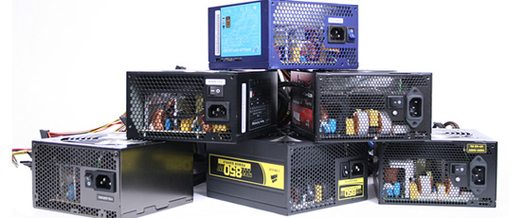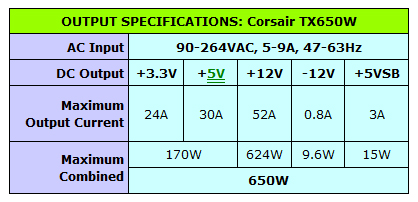
Choosing a power supply unit (PSU) for your new gaming rig is more difficult than many think. Most simply seek the wattage of a PSU, match it up roughly with the planned components and prey! More often than not, that tactic works initially however a failed power supply is the most common hardware faults any PC let alone a custom high end one.
“A PSU is the biggest overlooked component in a PC”
All of the components in a PC all share one thing in common – they are all powered by the same power supply. If a power supply fails then the entire system fails. If something like a hard disk fails then the system will work as normal minus the use of a hard disk.
Unfortunately, most people a reluctant to invest in a “good” power supply as it’s “just a power supply right?” Buyers believe it doesn’t make the PC run any faster or the graphics better (rightly so) so why spend that budget on a PSU when it can be put towards a graphics card upgrade or in the buyer’s pocket.
As computers become more and more power hungry choosing the right power supply becomes even more important than ever, this guide will help you in the right direction.
Wattage (w)
This is what most people look at when choosing a power supply – If you choose a PSU on this credential alone then you are most likely about to make a huge mistake. The biggest reason why many base how good a PSU is by how many watts it outputs, is because all manufacturers stuff the rated wattage in the product name or product model, even the good guys do this and when the day comes that manufacturers stop doing this the world will be a better place.
I would like to say use the rated wattage of a PSU as a rough guide but since it varies so much, don’t! I use the wattage of a PSU to help distinguish between the models and that’s it!
Every PSU out there should have a proper output specifications ratings spec to explain exactly what tasks it is up for, which should look something like this:

These ratings are also physically stuck to a PSU itself however you may not get chance to see this physical label until you have actually brought the PSU and it’s in your hands which could pose a problem.
The “good” power supply manufacturers will generally publish the output specifications, usually on the manufacturers website so if you have your eye on a particular PSU, find it. If you can’t find one then the manufacturer most likely doesn’t want you to find it for a reson, so steer well clear of these.
The advertised wattage can also mean two things;
1 – The continuous power – What wattage the PSU can constantly output2 – The Peak Power – The wattage that the PSU will peak at.
Peak power output means that and PSU can only output the advertised output for a short period of time and will have a much lower continuous output. A good rule of thumb is if a PSU only advertises the peak output, avoid it! A power supply that advertises a peak output of 700W may actually only be able to output around 500W for a sustained amount of time - If your PC needs 550W during sustained use, then a peak 700W PSU is likely to fail, and in the pretty display of sparks and maybe a fire will probably involve the failure taking out other important components such as the expensive graphics card, motherboard and hard drives.
The difference between essentially two different ratings is similar to the audio world where amplifiers can be given wattage in either PEAK or RMS. Anyone that has a slight know how in this field will make their choice based on the RMA output of a amplifier - The same rule applies in the computer power supply world - base you choice on the continuant output. One of the reasons why wattage is not an accurate medium to judge a power supply.
Rails
A rail is a power path within certain a supply which supplies a single voltage. If you look at our example output specifications table above you can see that the PSU in question has 5 “rails” - +3.3V, +5V, +12V,-12V and +5VSB each with an associated Ampere (A).
All of the important components in your PC are powered by the +12v rail.
Ampere (A)
The Ampere of a PSU is really what you want to look at, as these numbers are far more accurate than wattage. 
This is how you solve power equations.
P = Power (W)I = Amps (A)E = Volts (V)
Amps x Volts = Watts.
To calculate the real power available on the 12V Rail;52A x 12V = 624W
You then need to work out how much power the whole system will use, and if I am totally honest can vary massively from system to system. In a gaming PC the graphics card is the component that consumes the most power followed by the CPU. All the other components have negligible power consumption;
Motherboard - 10WCase fan - 5WHDD – 15WSSD – 1WCD/DVD Drive – 25WRAM Stick - 4WOverclocked 4770K CPU - 170W
Based on the above a high end overclocked system with a 4770K, A motherboard, 4 case fans, couple of hard drives, a SSD, an optical drive, 16GB of RAM (2 x 8GB Sticks) would use approximately 264W when running full tilt. To convert to Amps (W / V);
264 / 12 = 22 Amps
All that is left to do is to calculate how much juice is left for the powerful graphics card. For example an Nvidia GTX 770 requires a maximum of 19.16 Amps - 19.16 + 22 = 41.16 Amps. Therefore choosing a PSU that outputs over 41.16 Amps on the 12V Rail will be sufficient to power our example PC.
Nearly There!
It is always recommended to have more than you need - You only need one of the components to use more power that you think its using and it will top you over the edge. We will always say you want a minimum of a 20% cushion.
You can calculate the extra by simply multiplying the needed Ampage by 1.2 (1.25 if you want to do 25%). 41.16 x 1.2 = 49.39
Unfortunately, lots of numbers and lots of calculations to get your head around however this is the only way to do it right.
For the eagle eye among you, you will notice the ampere on the +3.3V and + 5V rail is 24A & 30A respectively. Try calculating the wattage of each rail – 24A x 3.3 = 79.2W and 30A x 5 = 150W and then adding them together – 79.2 + 150 = 229.2W. 229.2 is not what the PSU reports as the maximum combined 170 wattage. This is because the rails are not additive – you can load the 3.3V rail up to 24A and the +5V up to 30A but not at the same time.
Efficiency
Gaming Computers use lots of power and this will always be the case. Many dismiss a power supplies efficiency, probably because they are not paying the electricity bill! The more efficient a PSU is the cheaper it is to run.
To calculate efficiency DC Output divided by AC Input. Most PSU's are around 70-75% efficient, the better ones and ideally the ones you want, will have an efficiency certification (more on that shortly) where they will be of at least 80% efficient. The cheap and nasty units nearly always do not publish the efficiency, with many being below the 50% mark - Same rule applies as finding the output spec, if you can't find a published efficiency, steer well clear!
It is also worth noting that the energy lost (this would be the 25% in a 75% efficient PSU) is converted into heat - More heat means the system will run hotter and the PSU will need a more powerful and ultimately louder fan to cool it.
The Math behind it all
The amount of Energy used (also known commonly as units of energy) is measured in "Kilowatt Hours" (kWh). A Kilowatt is 1000W. At the time of writing this article British Gas currently charge 13.13 pence per kWh used. Of course this number is variable and over time given the rising prices of energy this will probably be higher but for the purpose of our calculations that's the number we are going to use.
We are also going to presume our custom built PC with its chosen PSU is going to need 600W of power at full tilt. 600W equates to 0.6 kWh. Over a period of 24 hours (multiply by 24) that is 14.4 kWh. Over a year (multiply by 365) this equates to 5256 kWh.
Use at 100% efficiency
In an ideal world a 100% efficient PSU supplying 600W will cost the following to run;
Hourly - 0.6 x 0.1313 = £0.7878Daily - 14.4 x 0.1313 = £1.89Yearly - 5256 x 0.1313 = £690.1128
The real world
Unfortunately because we do not live in an ideal world power supplies are not 100% efficient. A 50% efficient PSU needs to pull twice the amount of power (AC Input) in order to provide the required wattage (DC Output) so all of a sudden the 50% efficient PSU is going to actually be using 1200W in order to provide 600W of usable power which completely changes the amount of units of energy used. 0.6 kWh then becomes 1.2 kWh.
| PSU Efficiency | Required power to provide 600W | Energy Used |
| 50% | 1200W | 1.2 kWh |
| 70% | 960W | 0.96 kWh |
| 80% | 840W | 0.84 kWh |
| 90% | 720W | 0.72 kWh |
| 100% | 600W | 0.6 kWh |
So how many kWh is that over a year?
| PSU Efficiency | Calculation | Energy Used over a year (kWh) |
| 50% | 1.2 x 24 x 365 | 10512 |
| 70% | 0.96 x 24 x 365 | 8409.60 |
| 80% | 0.84 x 24 x 365 | 7358.40 |
| 90% | 0.72 x 24 x 365 | 6307.20 |
| 100% | 0.6 x 24 x 365 | 5256 |
Which works out to cost
| PSU Efficiency | Calculation | Yearly Cost (£) |
| 50% | 10512 x 0.1313 | £1380.22 |
| 70% | 8409.60 x 0.1313 | £1104.18 |
| 80% | 7358.40 x 0.1313 | £966.15 |
| 90% | 6307.20 x 0.1313 | £828.13 |
| 100% | 5256 x 0.1313 | £690.11 |
As you can see, a power supplies efficiently makes a huge difference to your yearly power bill! There is a £522.09 saving by choosing a 90% efficient PSU to a 50% efficient PSU. Clearly spending that little more on a PSU will pay for itself many times over over a yearly period.
Of course these numbers are all based on a fairly high power need (600W) over a sustained period of 24/7/365 use. Pretty much no one is going to be using their PC that much but it does clearly highlight how power efficiency is important.
A Step further
Let presume a gamer is using their PC for 4 hours a day, 5 days a week at a reduced power requirement of 400W, what happens to the numbers then.
So how many kWh is that over a year?
| PSU Efficiency | Calculation | Energy Used over a year (kWh) |
| 50% | 1.2 x 4 x 260 | 1248 |
| 70% | 0.96 x 4 x 260 | 998.4 |
| 80% | 0.84 x 4 x 260 | 873.6 |
| 90% | 0.72 x 4 x 260 | 748.8 |
| 100% | 0.6 x 4 x 260 | 624 |
Which works out to cost
| PSU Efficiency | Calculation | Yearly Cost (£) |
| 50% | 1248 x 0.1313 | £163.86 |
| 70% | 998.4 x 0.1313 | £131.08 |
| 80% | 873.6 x 0.1313 | £114.70 |
| 90% | 748.8 x 0.1313 | £98.31 |
| 100% | 624 x 0.1313 | £81.93 |
As you can see, there is still a noticeable saving to be had, the 90% efficiency compared to 50% saves you £65.55 a year. Choosing a 80% efficient PSU over a 70% efficient one saves you £16.38 a year. Whilst this may seem much more insignificant you will find that the price difference of an equal quality PSU between a 70% and 80% efficient unit is probably around that similar to what you save on your electricity bill. Given a PSU will probably last several years you reap that reward every year so the better PSU actually pays for itself several times over.
Efficiency Certification
In 2004 Ecos Consulting launched a power supply efficiency certification standard known as 80+ or 80 Plus. They certify manufacturers power supplies that are over 80% efficient at different rated loads for a sustained amount of time. Below is a table that shows what kind efficiency level qualifies for each test.
| 80 Plus test type | 115V internal non-redundant | 230V internal redundant | ||||||
|---|---|---|---|---|---|---|---|---|
| Percentage of rated load | 10% | 20% | 50% | 100% | 10% | 20% | 50% | 100% |
| 80 Plus | 80% | 80% | 80% | |||||
| 80 Plus Bronze | 82% | 85% | 82% | 81% | 85% | 81% | ||
| 80 Plus Silver | 85% | 88% | 85% | 85% | 89% | 85% | ||
| 80 Plus Gold | 87% | 90% | 87% | 88% | 92% | 88% | ||
| 80 Plus Platinum | 90% | 92% | 89% | 90% | 94% | 91% | ||
| 80 Plus Titanium | 90% | 92% | 94% | 90% | 90% | 94% | 96% | 91% |
When choosing a power supply for your custom made computer, take note of these certifications that manufacturers associate with their product as they will be saving you money. We wouldn't recommend you touch a PSU that does not have at least a 80 Plus Bronze certification.
Connectors
Power supplies come in all shapes and sizes and another variable to consider when choosing your power supply is what connectors it has. Pretty much every PSU manufacturer will list how many SATA, Molex, CPU power and 24 pin connectors its PSU will have. In today's market 95% of power supplies will come with sufficient connectors for your swish custom computer. Just be careful with the lower end units in case they are a molex or two short of what you actually need resulting in not being able to power a fan, hard drive or even worse a graphics card.
Modular power supplies are starting to become more common too, they allow you to connect up only the connectors you need rather than having them all present which can lead to cable clutter and potentially reduced airflow and unsightly looks. Modular PSU's do cost a little more and generally don't offer any performance benefit over a non modular version but if the cost difference is small and internal case looks are important they are definitely a variant you may wish to seriously consider.
Warranty
Like any other computer component, power supplies have a warranty attached to them from the manufacturer. This can vary from 1 year right up to a whopping 7 years. Given the reliability of power supplies has a whole and their tendency to fail picking a PSU with a year warranty only for it to fail 14 months into ownership would be a frustrating experience. Try to stick with a known brand as they will always have a better warranty than some unknown and if you can check out how long it is for and any exceptions and what country you have to send it to should the worst happen then you are on to a winning formula.
Looks
Believe it or not, some people actually choose their PSU based on how it looks rather than how it performs. Try not to get too caught up in how a PSU looks and aim for the other factors discussed in this guide as a primary driving force for your choice, although pairing a black PSU with an all back system can lead to some great visuals. Pre braided cables are also something to consider as the braid hides the mixed colours of the connector cables, most decent PSU's come with braid anyway but if you are concerned about looks check they come good looking cables.

